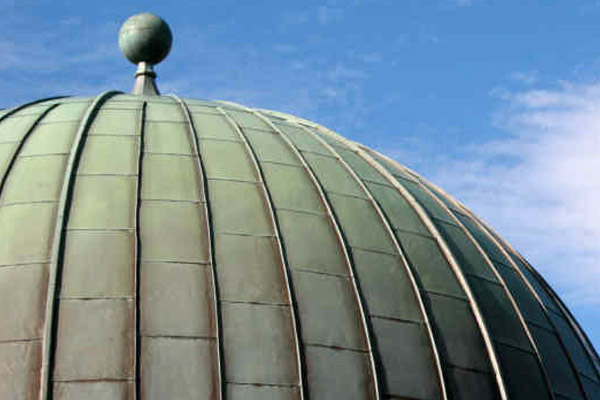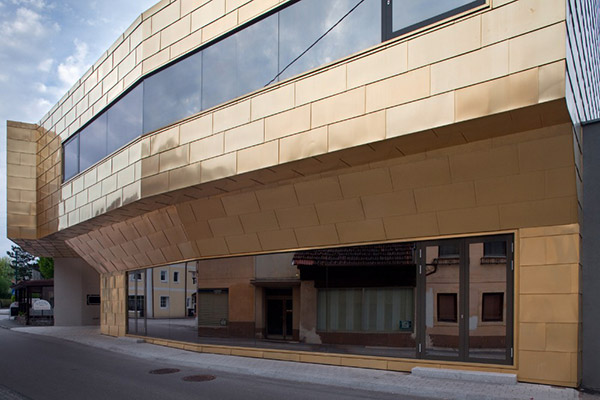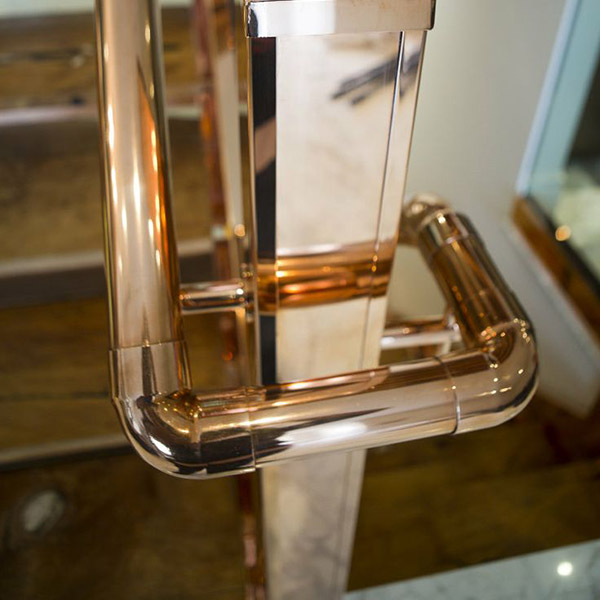We look at this beautiful material and its myriad of applications.
What is behind the ‘copper craze’?
Over recent years the use of copper in architecture and interior design has become all the rage both in mainland Europe and the US. This might seem a bit of a paradox when one hears that industrial demand in the BRIC economies is putting a strain on the copper supply chain, leading to increased prices and an increase in copper theft. So is this fashion trend linked to aesthetic appeal and/or performance advantages? Or is this trend linked to product innovation leading to new design applications? Has copper got the right environmental profile to meet the increasingly stringent requirements of sustainable design?
As an architectural metal copper was traditionally used for roofing because it is a leak proof, long wearing material that provides high resistance levels to corrosion compared to other sheet metals such as lead, aluminium, galvanized steel or zinc. Copper’s durability is linked to its low thermal expansion, which is 40% lower than zinc and lead. Also, copper’s high melting point ensures that it will not creep or stretch as some other metals do. As a result copper has long been regarded by architects as a low maintenance roofing solution with many other performance advantages. Firstly copper is half the weight of lead and only a quarter of tiled roofs which enables architects to design more cost efficient lightweight roof structures. Secondly copper also protects buildings from lightning and provides shielding from radio frequency because it absorbs radio and magnetic waves. Thirdly copper has also proved to be particularly cost effective: while copper’s initial cost is higher than some other architectural metals, it usually does not need to be replaced during the life of a building.
Rich colour variations over time
No other metals offer quite such a range of attractive colours comparable to copper and its various alloys: the red of copper, the gold of brasses, the chocolate brown of manganese bronzes and the shiny white nickel silvers provide architects with a wonderful range of design options. But what architects love most is the way copper changes colour over time, gradually achieving its unique and much coveted green patina. In fact the surface of the metal undergoes a series of colour changes: from iridescent/salmon pinks to oranges and reds interspersed with brassy yellows, blues, greens and purples. As the oxide thickens, these colours are replaced by russet and chocolate browns, dull slate greys or blacks, and finally to a light-green or blue-green. This weathering process is not necessarily uniform depending on the building’s exposure to sunlight and the way the copper has been joined. This creates again interesting patterns showing how the building reacts to its environment. Architects also like to play on contrasts by setting off the rich tones of copper against darker, duller materials.

Typical blue-green coloration of copper on this domed roof in Edinburgh
Bringing a new dimension to wall cladding
What has fuelled the interest of architects in recent years is the increasing availability of copper wall cladding solutions. On building exteriors, copper cladding sheets, shingles, and pre-fabricated panels shield buildings from the elements acting as first line of defence against wind, dust, and water. The cladding is lightweight, durable, and corrosion resistant, which is particularly important for large buildings. These can be manufactured for instance in interlocking profiled panels, horizontal sidings, bevelled panels or honeycomb systems. Rain screens and curtain walling (often linked with transoms and mullions) have gained increasing popularity in modern architectural design.
The other great virtue of this type of copper sheeting is that it is readily workable, so that it can be easily bent and shaped to the complex shapes of modern façades. The softly pummelled, irregular aspect of copper sheeting that has been hand crafted provides a particular aesthetic appeal. As the interest for copper cladding solutions has grown manufacturers have developed a whole range of solutions combining different types of copper alloys. For instance TECU® Gold is an alloy of copper and aluminium: the original golden surface starts to mellow and after natural weathering gradually forms a striking warm golden surface. Because it catches the sunlight copper cladding can be an interesting option to highlight a building within the urban fabric.

Community Centre façade in Tecu Gold, Wallern, Austria, 2009 by architects Schneider & Lengauer.
Photography by Kurt Hoerbst
Warm and luxurious interiors
Interior designers are also using the rich tones of copper and its alloys to add a feeling of luxury and prestige in the public areas of hotels, restaurants and office spaces. Copper aesthetically enhances interior wall systems, ceilings, fixtures, furniture, and hardware by bringing warmth, tranquillity, and calm. Typical copper-based products for interiors include panels, shingles, screens, tiles and mosaics punched from sheets of solid copper. Another traditional use of copper or brass is fine strips inlaid in woodwork such as staircases to increase their resistance to wear.
An added performance advantage of copper and copper alloys is their strong intrinsic antimicrobial properties against a wide range of disease-resistant bacteria, moulds, fungi and viruses. After years of extensive testing over 300 different copper alloys (copper, brasses, bronzes, copper-nickels, and nickel- silvers) have been recognized as antimicrobial materials. This development is creating markets for all sorts of architectural ironmongery. Copper handrails, counter tops, hallways, doors, push plates, kitchens, and bathrooms are just some of the antimicrobial products approved for hospitals, airports, offices, and schools to kill harmful bacteria. When it is hand crafted copper sheeting can include hammering patterns to give embossed finishes with an antique rustic touch.

Copper handrail and newel post to staircase by interior designer Katharine Pooley
The attractive range of colours of copper and copper alloys may be maintained by using a transparent lacquer or polishing periodically with a natural wax. However if a designer wishes to take advantage of the antimicrobial properties of copper alloys, lacquering is not advised since any coating will mask the antimicrobial efficacy. Copper and copper alloys may also be chromium plated to give a hard, shiny and attractive finish. If corrosion resistance is desirable, a slightly thicker plating will offer this as well.
Such is the success of copper that manufacturers have tried different coating techniques on other metals to imitate its aspect. Super-hard PVD coatings applied to chrome plated materials or stainless steel allowsmanufacturers to obtain tones similar to copper or brass with an antimicrobial finish
Good green credentials
Copper is a sustainable material. Its durability offers long service with little maintenance. The long lifetime of copper roofing and cladding has a significant positive effect on whole life cycle assessments of copper versus other materials in terms of embodied energy. Copper and its alloys are virtually 100% recyclable and can be recycled infinitely without any loss of quality. Currently, around 40% of Europe’s annual copper demand and about 55% of copper used in architecture come from recycled sources. New copper coil and sheet often have 75%-100% recycled content. And copper recycling requires only around 20% of the energy needed to extract and process primary metal.